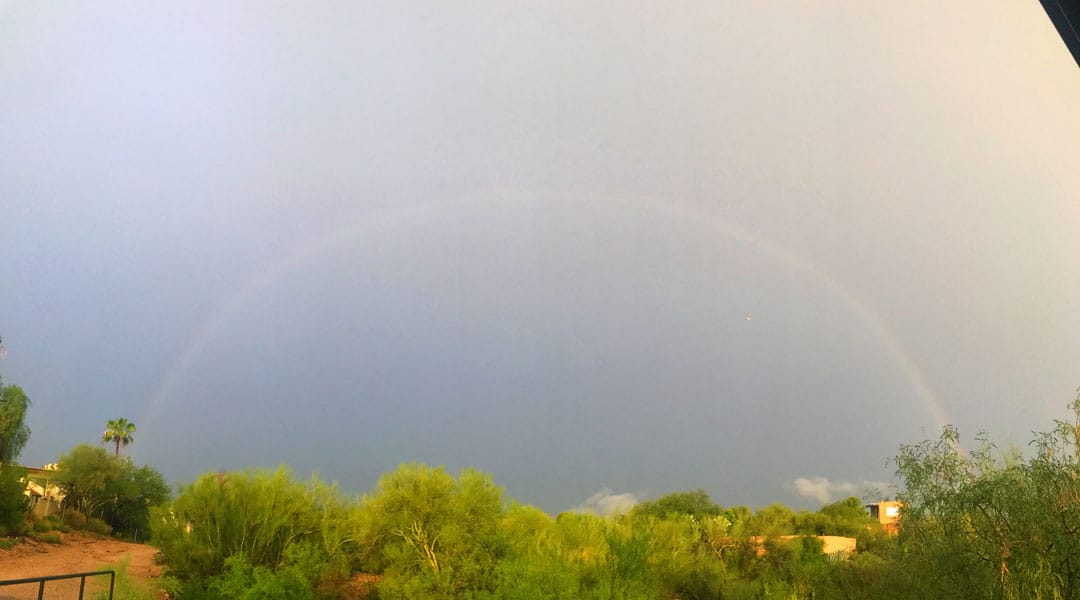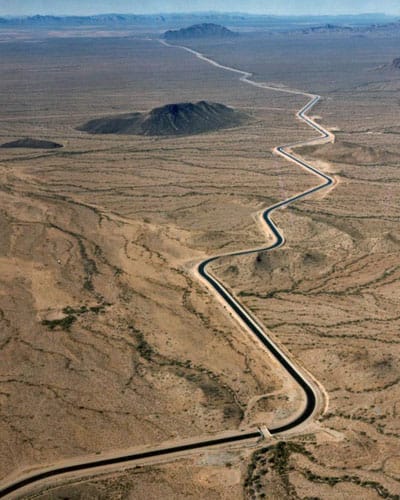With all of the things going on in the world right now, maybe the last thing you want to read about is a drought. But here’s the thing: it’s not that bad…yet. There are still steps that you can take to prevent a water shortage. Other things in the world may be outside of our control, but making some changes to how we use water – both in our homes and in our gardens – can make a big difference.
In this article, we talk about the 20-year drought that Tucson is experiencing, how that affects our water supplies, what preparations have been made, and what we as Tucson-area citizens can do.
The Bad News About Tucson's Drought
Tucson’s Current Drought Status
First, the bad news. Yes, Tucson is in the midst of a 20-year drought. Right now, parts of Pima County are under “Extreme Drought,” some are “Severe Drought,” and some are “Moderate Drought.” There's only one level more serious than Extreme Drought - Exceptional Drought.
According to the City of Tucson, the Tucson area has been in a drought since 2000. However, this is the first time that the Tucson area has been in a “severe” drought since July 2018.
You can see a map of the state's current drought status here – it is updated weekly >>
You can also see what each of the kinds of drought mean on this map >>
Rising Temperatures Mean Lower Water Levels
Our water supply is partially from the Colorado River – which, it has recently been discovered, loses water faster as temperatures rise. With some of the hottest months on record this past summer, that means a loss of a significant amount of water
When trees are removed, and especially when they are replaced by buildings and asphalt that hold on to heat, the temperature of a block, a neighborhood, and a city will continue to rise.
Unfortunately for the Tucson (and Phoenix) areas, monsoon season 2020 has been more of a “non-soon,” which has now happened for the second year in a row. The reasons for that are fascinating, and you can learn all about them in this article from the Arizona Department of Water Resources: “Non-Soon” Version 2.0 Has Arrived And It’s Bigger, Hotter And Drier Than Ever
Thanks to record high temperatures (“July 2020 was the hottest month ever in Phoenix and Tucson”) and lack of significant monsoon moisture, Tucson has entered more and more of a drought state.
And, sadly, forecasters are predicting a much drier winter as well.
Rising Populations Necessitate More Water Usage
The population in Arizona, and Tucson in particular, is growing rapidly. As we all know, Tucson is a great place to live, and more and more people are discovering that for themselves. Every new building and house needs water - both to build it and for ongoing use.
The Good News About Tucson's Drought
Arizona Has Recovered from Droughts Before
Multiple decades of drought have happened in Arizona before, followed by years of adequate rainfall. There is still hope that a similar sequence of events may happen again. For instance, there was a prolonged drought from 1849 to 1905, and another from 1941 to 1965, but then there was a period of wet weather from 1979 through 1983. We can hope that there may be some end to this drought that has lasted the last 20 plus years.

Trees Can Help
You know what lowers temperatures? Trees! It may seem counter-intuitive, but planting trees can actually help our water resources in the long run.
Learn more about how trees can reduce "heat islands" from the EPA >>
Right now, there’s enough water
Arizona has diversified the water supply for our state, with water coming from multiple sources. According to Arizona Water Facts, our water comes from these four sources:
- 36% from the Colorado River
- 42% from groundwater
- 18% from in-state rivers
- 4% is reclaimed water
You may have heard that Arizona uses less water now than we did in 1957, despite rapid population growth. According to this article, that claim is true. Thanks to measures such as building and plumbing codes, resourceful homeowners, and policy and law changes, our usage has decreased while our population has increased. The sources for our water have changed slightly during that time as well, as we now use more surface water than groundwater, and have implemented water recycling (or reclaimed water).
Plans for Drought

The Central Arizona Project brings water from the Colorado River to parts of Arizona
Finally, plans have been in place for the future of our water for decades. All municipal water providers (such as Tucson Water) are required by law to publish and update a drought preparedness plan detailing what will happen if/when drought conditions reach exceptional drought levels, where shortages of water create a water emergency.
Parts of those plans have included:
- The Central Arizona Project (CAP) - a 336-mile project that brings water from the Colorado River to Arizona
- The Clearwater Program - According to the City of Tucson, "Tucson’s allocation of Colorado River water is delivered to Tucson via the Central Arizona Project (CAP) canal. That Colorado River water is allowed to sink into the ground and recharge the aquifer in Avra Valley at CAVSARP and SAVSARP where it is stored for future use. It is then pumped to the surface and held in the Clearwell Reservoir before it is delivered to Tucson Water customers."
- The Clearwell Reservoir holds 60 million gallons of water from the Clearwater Program
What You Can Do
Be Informed
Water is top-of-mind for not only Arizona residents, but Arizona lawmakers. There are countless reports, studies, and plans that are discussed and often voted on, especially if a new resource is being used or water sustainability laws are being considered. Some of those include:
- The Arizona Department of Water Resources lists current initiatives as well as laws, rules and policies pertaining to water usage in Arizona.
- Tucson Water Conservation Program FY 2018-2019 Annual Report
- Learn more about where Arizona water comes from and how it is used (or stored) in this easy-to-understand infographic at Arizona Water Facts.
Make Changes in Your Yard and Home
Prioritize Trees and Shrubs
The University of Arizona Cooperative Extension just published a helpful guide for how to take care of your landscape during periods of hot temperatures and little rainfall. The guide emphasizes focusing on trees and shrubs, which last longer and provide more benefits than flowers and vegetables. Established trees, especially, are an investment worth protecting. If they die or need to be removed, the process is costly and will take years for a replacement tree to grow.
Ensure you aren't wasting water
Proper watering practices include watering at the correct time of day, making sure you are watering the roots of trees and shrubs (not the leaves), and not overwatering. Make sure you're using the correct amount of water by using this helpful guide from wateruseitwisely.com.
Wateruseitwisely.com and other sites can teach you ways to reduce your water usage, from focusing on native plants to installing an irrigation timer.
Use mulch and compost
Mulch is helpful in regulating the temperature of the soil (it can keep soil cooler during the blazing hot summer months). Organic mulch (made from things like shredded bark, wood chips, straw, compost, pine needles, pecan shells, etc.) will break down over time, adding organic material and nutrients to the soil for the trees and shrubs to absorb. A nice layer of mulch can also keep weeds from popping up between your other plants.
Consider an irrigation system if you don't have one already
An irrigation system is a good way to ensure that water reaches the plants that need it. Unlike sprinklers, which water a wide area, irrigation systems have emitters that can be placed near plants and flowers to guarantee a consistent water source. Irrigation systems let you control when to water and for how long, allowing you to change the schedule based on the time of year, rainfall amount, and more.
Learn about alternative water-saving programs
Rain barrels? Efficient appliances? If you've ever been interested in alternative ways to save water (and save on your water bill!), now would be a great time to research opportunities. There are several rebates available to Tucson Water customers who participate in water conservation efforts. Learn more about those rebates on Tucson Water's website.
Adapt your yard and garden for arid conditions
While some people enjoy green grass and non-native plants, not everyone needs to have that type of yard. Xeriscaping and native plants and trees need less water, and they are more adapted to our Tucson climate. Plenty of birds, insects, and animals rely on native plants for food and shelter, and having a healthy ecosystem can only improve your own health.
Find other ways to reduce water usage - including indoors
There are a surprising number of ways to reduce your water usage every day. Now that you are aware that the Tucson area is in the midst of a drought, you may want to change some of the habits that you do daily - maybe you'll start turning off the faucet while you brush your teeth, use a bucket to collect shower water while it is getting to the perfect temperature, or discontinue using your garbage disposal. Water utility companies, water conservation companies, and websites such as drought.gov have dozens of suggestions on where you can start.
In Conclusion
So yes, Tucson is in the midst of an extreme drought. However, thanks to advanced planning and creative ways of getting water, the drought has not impacted our daily lives as of yet. With that in mind, it's a good idea to learn how to use less water in your life, both inside your home and outside in your yard and garden. Educating yourself on water laws, resources, and programs can help you become more informed and can lead to your personal contribution to water conservation. We hope that this article has made you more aware of our current situation and has given you plenty of resources.